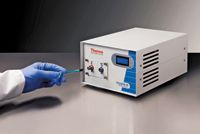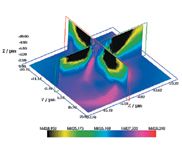Products
Product Resources
Detector
Andor's iDus LDC-DD 416 platform is designed to provide a combination of low dark noise and high QE. According to the company, the detector is suitable for NIR, Raman, and photoluminescence and can reduce acquisition times, removing the need for liquid nitrogen cooling. Andor Technology, South Windsor, CT;

CCD cameras
Horiba Scientific's liquid-nitrogen-cooled Symphony II and thermoelectrically cooled Synapse CCD cameras are available with the company's QExtra technology, which reportedly improves quantum efficiency of back-illuminated CCDs (BIDDs) over a broad spectral range, while suppressing etaloning effects. According to the company, the technology provides low-light detection capabilities at wavelengths ranging from 300 nm to 1000 nm with quantum efficiency higher than 90%. Horiba Scientific, Edison, NJ;

Spectroscopy software
OceanView spectroscopy software from Ocean Optics is designed with a combination of data processing capabilities and a graphical user interface for use with the company's miniature spectrometers. According to the company, the software is customizable and includes a schematic view that provides a visual road map of data flow from spectral inputs to processed results. Ocean Optics, Dunedin, FL;

EDXRF spectrometer
Shimadzu's EDX-LE energy dispersive X-ray fluorescence spectrometer is designed for screening elements regulated by RoHS/ELV directives. According to the company, the spectrometer is equipped with automated analysis functions and a detector that does not require liquid nitrogen. Shimadzu Scientific Instruments, Columbia, MD;

Benchtop spectrometers
BaySpec's SuperGamut benchtop spectrometers incorporate multiple spectrographs and detectors, optional light sources, and sampling optics. According to the company, customers can choose wavelength ranges from 190 to 2500 nm, combining one, two, or three multiple spectral engines depending on wavelength range and resolution requirements. BaySpec, Inc., San Jose, CA;

Data reviewing and sharing iPad app
The Thermo Scientific NanoDrop user application for iPad is designed to enable users of the company's NanoDrop instruments to take sample data on the go. According to the company, the app allows users to import and view data, and compare concentration, purity, and spectral information. Thermo Fisher Scientific, San Jose, CA;
www.thermoscientific.com/nanodropapp

Plasma atomic emission spectrometer
The 4100 MP-AES system from Agilent is designed as an elemental analysis instrument that runs entirely on air. According to the company, the spectrometer uses a nitrogen-based plasma and does not require other gases. Agilent Technologies, Santa Clara, CA;

FT-IR microscope
The Lumos stand-alone FT-IR microscope from Bruker Optics is designed for visible inspection and infrared spectral analysis. According to the company, all internal moveable components are motorized and the instrument's software guides operate stepwise through the process of data acquisition. Bruker Optics, Billerica, MA;
www.brukeroptics.com/lumos.html

X-ray windows
DuraBeryllium X-ray windows from Moxtek are designed to be resistant to many solvents, acids, and bases. The company's DuraBeryllium Plus film reportedly provides maximum corrosion resistance. According to the company, the product is a low-Z material that when applied to beryllium creates a hermetic, corrosion-resistant window that is used for ultrahigh-vacuum applications. Moxtek, Orem, UT;

LED light source
A full-spectrum fiber-coupled LED light source with an SMA connector for spectroscopy applications is available from Mightex. According to the company, the LED source covers the range from 380 nm to 780 nm continuously, and the spectral range can be expanded by adding more LEDs in both ends of the spectrum. Mightex, Pleasanton, CA;

Handheld Raman spectrometer
B&W Tek's NanoRam handheld Raman spectrometer is designed with an embedded 2D barcode scanner, batch scanning capabilities, an IP-64 rated (dust tight and splash proof) housing, Ethernet connectivity, and other software enhancements. According to the company, two sampling accessories for the spectrometer have also been introduced, a 12-in. immersion shaft and a tablet holder. B&W Tek, Newark, DE;
www.bwtek.com/products/nanoram

Confocal Raman microscope
Horiba Scientific's XploRA One Raman microscope is designed for QA–QC and analytical laboratories in the industrial and routine analytical sectors. According to the company, the microscope's user interface is powered by its LabSpec 6 software. Horiba Scientific, Edison, NJ;
www.horiba.com/us/en/scientific/marketing-us/xplora-one/

NMR spectrometer
The Thermo Scientific picoSpin 45 Proton NMR spectrometer is designed as a benchtop device that processes liquid samples as small as 30 µL. According to the company, the spectrometer weighs less than 5 kg, can be shared by multiple laboratories, and has a fluid capillary cartridge that allows liquids to be injected without the need to use NMR tubes. Thermo Fisher Scientific, San Jose, CA;

Raman microscope
Renishaw's inVia Raman microscope is designed with a 3D imaging capability that allows users to collect and display Raman data from within transparent materials. According to the company, the instrument's StreamLineHR feature collects data from a series of planes within materials, processes it, and displays it as 3D volume images representing quantities such as band intensity. Renishaw, Hoffman Estates, IL;

ATR accessory
Diamond, Ge, and Si crystal options and a specular reflection plate from PIKE Technologies are designed for use with its MIRacle single-reflection attenuated total reflection (ATR) accessory for FT-IR applications. According to the company, an optional force sensor connected to a digital readout, a liquid retainer, a flow-through attachment, a selection of clamps, and dedicated pressure tips for use with various sample types are also available for the ATR accessory. PIKE Technologies, Madison, WI;

EDXRF spectrometers
Rigaku's NEX QC EDXRF spectrometers are designed to provide routine elemental measurements across a diverse range of matrices, including liquids of any viscosity, solids, thin films, alloys, slurries, powders, and pastes. According to the company, the spectrometers are designed for heavy industrial use, either on the plant floor or in remote field environments. Applied Rigaku Technologies, Inc., Austin, TX;

PAT microsite
A microsite from Hellma is designed to provide PAT users with comprehensive information on the topic. According to the company, site visitors can build a ready-to-order optical immersion probe with its on-line configurator. Hellma USA, Inc., Plainview, NY;

X-ray windows
Amptek's C series low-energy X-ray windows for X-ray fluorescence applications are made of silicon nitride with aluminum coating and are designed to extend the low energy response of the company's silicon drift detector down to carbon. According to the company, the windows provide an alternative to beryllium windows. Amptek, Inc., Bedford, MA;

Laboratory-based LIBS analyzers
ChemScan laboratory-based analyzers from TSI are designed to use laser-induced breakdown spectroscopy to provide identification of materials and chemical composition of solids. According to the company, the analyzers are equipped with the company's ChemLytics software. TSI Incorporated, St. Paul, MN;

1064-nm NIR Raman spectrometers
Portable Raman spectrometers from StellarNet are designed to use InGaAs detectors to capture NIR spectra induced by 1064-nm lasers. According to the company, the high-resolution model (Raman-HR-TEC-IG) achieves 8 cm-1 resolution with a 1024-element PDA detector, and the standard resolution instrument achieves 16 cm-1 resolution and has a 512-element PDA detector. StellarNet Inc., Tampa, FL;
www.stellarnet.us/PopularConfigurations_ramansystems.htm

Fluorescence mercury analyzer
The FMA-80 fluorescence mercury analyzer from Milestone is designed for the simultaneous atomic fluorescence and atomic absorption measurements of water-based samples and matrix digestates for mercury analysis. According to the company, there is no need for sample dilution. Milestone, Inc., Shelton, CT;

Mercury analyzers
The Hydra II mercury analyzers from Teledyne Leeman Labs are designed to provide configuration flexibility. According to the company, the analyzers can be configured to conduct the analysis of liquids by sample digestion followed by cold vapor atomic absorption or cold vapor atomic fluorescence, and the direct analysis of solid or semisolid sample matrices through thermal decomposition followed by cold vapor atomic absorption. Teledyne Leeman Labs, Hudson, NH;

Controlled substance reference database
PANalytical's CanDI-X controlled substance reference database for X-ray diffraction reportedly contains more than 500 traceable reference patterns for most hard narcotics, street and prescription drugs, precursors, excipients, and common steroids. According to the company, the database allows nondestructive identification of complex mixtures and identification of narcotics incorporated into creams and petroleum jellies. PANalytical, Westborough, MA;

Photovoltaic measurement system
Newport Corporation's Oriel IQE-200 photovoltaic cell measurement system is designed for simultaneous measurement of the external and internal quantum efficiency of solar cells, detectors, and other photon-to-charge converting devices. The system reportedly splits the beam to allow for concurrent measurements. The system includes a light source, a monochromator, and related electronics and software. According to the company, the system can be used for the measurement of silicon-based cells, amorphous and mono/poly crystalline, thin-film cells, copper indium gallium diselenide, and cadmium telluride. Newport Corporation, Irvine, CA;


LIBS Illuminates the Hidden Health Risks of Indoor Welding and Soldering
April 23rd 2025A new dual-spectroscopy approach reveals real-time pollution threats in indoor workspaces. Chinese researchers have pioneered the use of laser-induced breakdown spectroscopy (LIBS) and aerosol mass spectrometry to uncover and monitor harmful heavy metal and dust emissions from soldering and welding in real-time. These complementary tools offer a fast, accurate means to evaluate air quality threats in industrial and indoor environments—where people spend most of their time.
NIR Spectroscopy Explored as Sustainable Approach to Detecting Bovine Mastitis
April 23rd 2025A new study published in Applied Food Research demonstrates that near-infrared spectroscopy (NIRS) can effectively detect subclinical bovine mastitis in milk, offering a fast, non-invasive method to guide targeted antibiotic treatment and support sustainable dairy practices.